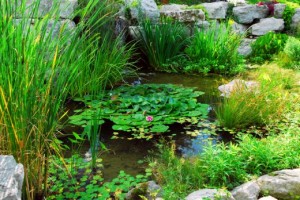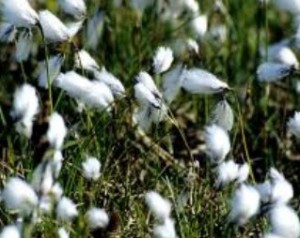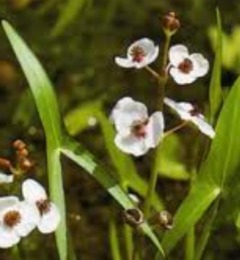





The garden pool or water garden feature is an important asset for nature conservation. Even when established in an urban garden, where there may not appear to be any obvious wildlife, it has a role to fill.
Surprisingly, in such extensive conurbations, there will be aquatic species that will welcome it as a safe retreat. Where they come from is often a mystery, but it is quite likely that other garden pools provide watery havens and act rather like stepping stones across a developed landscape.
 Of course, pools are also important in the countryside. Many may believe that water gardens have no part to play in conservation in rural areas, but the rolling fields and woodlands are an agricultural desert.
Of course, pools are also important in the countryside. Many may believe that water gardens have no part to play in conservation in rural areas, but the rolling fields and woodlands are an agricultural desert.
Field ponds have been drained in the name of progress, and very little natural water is to be found on farmland compared with fifty years ago. Garden pools are the last retreat for many species that have largely been driven from their traditional habitat.
If the main objective of your garden pool is to conserve native wildlife, it is essential to study the plants and creatures that are common to your area.
Providing an additional facility for the plants, birds, insects and amphibians of your immediate locality will be much more fruitful than trying to represent the native flora and fauna of the entire country. For example, it is not truly natural conservation to bring together the cotton grass (Eriophorum angustifolium) and arrowhead (Sagittaria sagittifolia) when it is unlikely that these species would be found growing close to each other in the wild.
 While purists may insist that the plants you grow should be truly local to ensure genetic purity, it may be difficult to obtain suitable material legally. The law of many countries precludes the taking of any such stock from the wild and introducing it to your garden, unless threatened by some other legal human activity.
While purists may insist that the plants you grow should be truly local to ensure genetic purity, it may be difficult to obtain suitable material legally. The law of many countries precludes the taking of any such stock from the wild and introducing it to your garden, unless threatened by some other legal human activity.
With widely distributed species, the danger of polluting the local genetic base is seen by botanists as undesirable, but in reality, this may occur, for gardeners who wish to plant for wildlife conservation will use horticulturally raised stock.
By its very nature, this is likely to be clonal: propagated originally from an individual and, when increased vegetatively, without diversity. Such plants are also likely to be the most appealing visually, as gardeners select for appearance and, naturally, choose individ uals that are most attractive from which to propagate.
 Only in very recent times has there been an awareness of the importance of variation within a species in nature. This has led to the availability of non-selected stock, but only in very limited quantities, which is the next best thing to obtaining local plants.
Only in very recent times has there been an awareness of the importance of variation within a species in nature. This has led to the availability of non-selected stock, but only in very limited quantities, which is the next best thing to obtaining local plants.
In reality, native plant conservation is best left to the bodies that manage nature reserves. However, water gardeners can play a useful role in conservation by providing havens for aquatic insect life and amphibians. These are not creatures that you introduce, but which appear quite naturally if your pond is set up correctly. They will be indifferent to the origins of the plants upon which they may depend, provided that these are of the appropriate species.
Deciding to conserve specific types of wildlife is pointless, for they will naturally find you if the conditions are correct. Such conditions can be created by carefully observing what grows in the ponds and wetlands of your locality. You may have little idea of the diverse aquatic fauna on your doorstep, but this will not be important if you incorporate appropriate planting. A mixture of local species will bring in migrating wildlife quite quickly, as will any body of open water, no matter how small.
When considering a true wildlife water garden, an early appreciation of its likely appearance must be obtained. To be truthful, most creations of this kind are untidy. It is not simply the tangled growth of largely dull plant species that creates this appearance, but also the fact that the plants must remain largely undisturbed to be successful in attracting aquatic fauna. There can be none of the regular manicuring that is associated with the decorative garden pond.
However, some management is necessary, although this should be subtle and minimal. For example, one plant species must not be allowed to encroach upon another, while floating species should be prevented from obscuring the surface of the pool and reducing the light beneath, which would cause the demise of the essential submerged aquatics.
In a pool with native species that grow naturally in the surrounding countryside, a variety of life will evolve, but not always to the advantage. Of the wildlife that you may wish to conserve and enjoy. The entire project will be fulfilling, but there must be an awareness that with such a feature, beauty is very much in the eye of the beholder.
Copyright © www.100flowers.win Botanic Garden All Rights Reserved